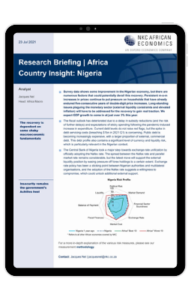Africa | Country Insight: Nigeria

Progress in passing the Petroleum Industry Bill (PIB) and official adoption of the Nafex rate are two significant policy steps in the rights direction. However, with elevated price inflation and just 30.6 million Nigerians out of a population of nearly 210 million considered fully employed, households are under severe strain. Long-standing issues plaguing the monetary sector (external liquidity constraints and elevated inflation) will have to be addressed for the recovery to gain real traction.
What you will learn:
- A tense political environment has encouraged authorities to delay the suspension of subsidies, but fiscal pressures and the regulatory requirements stemming from the PIB could force the government to scrap this form of financial support.
- Public debt is becoming increasingly expensive, with a larger proportion of external, commercial debt. This debt profile also contains a significant level of currency and liquidity risk, which is particularly relevant in the Nigerian context.
- Lagos is by far the largest consumer market in West Africa, with spending totalling an estimated N13.2trn in 2020. Looking ahead, we expect the strongest growth in consumer spending to take place in Abuja and the smaller markets of Port Harcourt and Onitsha.
Tags:
Related Services

Post
US-China trade relationship not as one sided as it appears
Research Briefing Africa | Country Insight: Nigeria Download the full report to read more
Find Out More
Post
Japan’s tariff turbulence to flatten near-term growth
We've cut our GDP growth forecasts for Japan by 0.2ppts to 0.8% in 2025 and by 0.4ppts to 0.2% in 2026, reflecting higher US tariffs and heightened global trade policy uncertainty. We now forecast that Japan's economy will barely grow over 2025-2026 on a sequential basis.
Find Out More